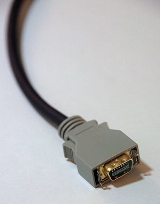
D4 video connector
Encyclopedia
A D-Terminal or D-tanshi is a type of analog video connector found on Japanese consumer electronics, typically HDTV
, DVD
, Blu-ray, D-VHS
and HD DVD
devices. It was developed by the EIAJ
(Electronic Industry Association of Japan) in its standard, RC-5237, for use in digital satellite broadcast tuners. In appearance it is a small flat trapezic connector, the same connector as the AAUI
connector used by Apple Computer
for some time to connect to ethernet
.
 A D-Terminal connector carries a component video
A D-Terminal connector carries a component video
signal (YPBPR
). A device with a D5 connector can understand and display the following video signals:
A device with a D-Terminal connector supports that level and lower D-Terminal signal. For example, a D4 connector can be used with a D4, D3, D2, or D1 signal, but not with a D5 signal.
It is possible to use a simple breakout cable to connect a D-Terminal connector to a standard 3 RCA jack or BNC
component connection.
High-definition television
High-definition television is video that has resolution substantially higher than that of traditional television systems . HDTV has one or two million pixels per frame, roughly five times that of SD...
, DVD
DVD
A DVD is an optical disc storage media format, invented and developed by Philips, Sony, Toshiba, and Panasonic in 1995. DVDs offer higher storage capacity than Compact Discs while having the same dimensions....
, Blu-ray, D-VHS
D-VHS
D-VHS is a digital recording format developed by JVC, in collaboration with Hitachi, Matsushita, and Philips. The "D" in D-VHS originally stood for Data VHS, but with the expansion of the format from standard definition to high definition capability, JVC renamed it Digital VHS and uses that...
and HD DVD
HD DVD
HD DVD is a discontinued high-density optical disc format for storing data and high-definition video.Supported principally by Toshiba, HD DVD was envisioned to be the successor to the standard DVD format...
devices. It was developed by the EIAJ
Electronic Industries Association of Japan
Founded in 1948, the Electronic Industries Association of Japan was one of two Japanese electronics trade organizations that were merged into the Japan Electronics and Information Technology Industries Association ....
(Electronic Industry Association of Japan) in its standard, RC-5237, for use in digital satellite broadcast tuners. In appearance it is a small flat trapezic connector, the same connector as the AAUI
Apple Attachment Unit Interface
Apple Attachment Unit Interface is a mechanical re-design by Apple of the standard Attachment Unit Interface used to connect Ethernet transceivers to computer equipment...
connector used by Apple Computer
Apple Computer
Apple Inc. is an American multinational corporation that designs and markets consumer electronics, computer software, and personal computers. The company's best-known hardware products include the Macintosh line of computers, the iPod, the iPhone and the iPad...
for some time to connect to ethernet
Ethernet
Ethernet is a family of computer networking technologies for local area networks commercially introduced in 1980. Standardized in IEEE 802.3, Ethernet has largely replaced competing wired LAN technologies....
.
D1~D5 types

Component video
Component video is a video signal that has been split into two or more component channels. In popular use, it refers to a type of component analog video information that is transmitted or stored as three separate signals...
signal (YPBPR
YPbPr
' is a color space used in video electronics, in particular in reference to component video cables. is the analog version of the YCBCR color space; the two are numerically equivalent, but YPBPR is designed for use in analog systems whereas YCBCR is intended for digital video. cables are also...
). A device with a D5 connector can understand and display the following video signals:
- D1 480i480i480i is the shorthand name for a video mode, namely the US NTSC television system or digital television systems with the same characteristics. The i, which is sometimes uppercase, stands for interlaced, the 480 for a vertical frame resolution of 480 lines containing picture information; while NTSC...
(525i): 720 × 480 interlaced - D2 480p480p480p is the shorthand name for a video display resolution. The p stands for progressive scan, i.e. non-interlaced. The 480 denotes a vertical resolution of 480 pixel high vertically scanning lines, usually with a horizontal resolution of 640 pixels and 4:3 aspect ratio or a horizontal resolution of...
(525p): 720 × 480 progressiveProgressive scanProgressive scanning is a way of displaying, storing, or transmitting moving images in which all the lines of each frame are drawn in sequence... - D3 1080i1080i1080i is the shorthand name for a high-definition television mode. The i means interlaced video; 1080i differs from 1080p, in which the p stands for progressive scan. The term 1080i assumes a widescreen aspect ratio of 16:9, implying a frame size of 1920×1080 pixels...
(1125i): 1920 × 1080 interlaced - D4 720p720p720p is the shorthand name for 1280x720, a category of High-definition television video modes having a resolution of 1080 or 720p and a progressive scan...
(750p): 1280 × 720 progressive - D5 1080p1080p1080p is the shorthand identification for a set of HDTV high-definition video modes that are characterized by 1080 horizontal lines of resolution and progressive scan, meaning the image is not interlaced as is the case with the 1080i display standard....
(1125p): 1920 × 1080 progressive
A device with a D-Terminal connector supports that level and lower D-Terminal signal. For example, a D4 connector can be used with a D4, D3, D2, or D1 signal, but not with a D5 signal.
It is possible to use a simple breakout cable to connect a D-Terminal connector to a standard 3 RCA jack or BNC
BNC connector
The BNC connector ' is a common type of RF connector used for coaxial cable. It is used with radio, television, and other radio-frequency electronic equipment, test instruments, video signals, and was once a popular computer network connector. BNC connectors are made to match the characteristic...
component connection.

